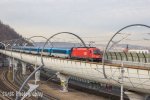Sorry if it wasn't clear, but there's a general rewiring of the station electrics for the shops, lights, displays etc, that is nothing to do with any potential electrification.Does anyone know if the plan is to wire all the platforms at BTM or just a few? With the possibility of wiring it all at a later date?
If the lines were to be electrified, I would be surprised if any platforms were not electrified, since it would impose an operational restriction that would cause far more issues than any money saved would be worth. However it is possible that some could be done as part of Filton Bank and then some done as part of Chippenham-Bristol.
The bigger question for me is how far west the wires would get, and my suspicion is that only the Carriage Road at Bedminster would be wired, with limited if any overrun towards Parson Street, and probably no wires on the sidings at the north side of the west end.
In theory the Filton Abbey Wood terminator could go over to an EMU, depending on the exact limits of electrification, but would require the diagrams being redone. Removing diesel idling from Temple Meads would be a benefit in itself, and it opens the opportunity for the peak Paddington-Parkway 387s to be extended to Temple Meads, as well as giving greater flexibility for extras between Bristol and Cardiff on event days (which are fairly regular).If Filton Bank gets wired anytime soon there's not a lot that will benefit currently. The Bristol TM-London fasts aren't returning; the only moves that will use it are Cardiff-Exeter services and ECS moves to/from Stoke Gifford. If however BEMUs take over all the Bristol metro services, then it becomes very valuable.
It also makes BEMUs and Bi-Modes more viable as it gives an option for electric running to be extended.




